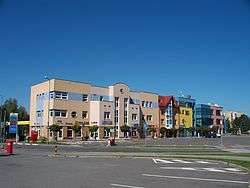Lutyně (Orlovâ)

Lutyně (Polish: Lutynia, German: Leuten) is a district of the city of Orlová in Karviná District, Moravian-Silesian Region, Czech Republic. It was a separate municipality, historically prior to World War II known as Polská Lutyně (Polish: Lutynia Polska, German: Polnischleuten), and later as Horní Lutyně (Polish: Lutynia Górna, German: Ober-Leuten). It became administratively a part of Orlová in 1946, as opposed to its sister settlement of Dolní Lutyně, which remained independent. It is now the largest district of the town, with a population of over 26000, roughly three quarters of the Orlová population.
History
The village of Lutyně was first mentioned in a Latin document of Diocese of Wrocław called Liber fundationis episcopatus Vratislaviensis from around 1305 as item in Luthina LXXI) mansi.[1][2][3] It meant that the village was supposed to pay tithe from 71 greater lans. The village could have been founded by Benedictine monks from Orlová abbey[4] and also it could be a part of a larger settlement campaign taking place in the late 13th century on the territory of what will be later known as Upper Silesia. A separate village of Horní Lutyně was first mentioned in 1365,[5] and later in 1450 together with its sister settlement as Lutynie utrumque Theutonicum et Polonicum.[6]
Politically the villages belonged initially to the Duchy of Teschen, formed in 1290 in the process of feudal fragmentation of Poland and was ruled by a local branch of Piast dynasty. In 1327 the duchy became a fee of Kingdom of Bohemia, which after 1526 became part of the Habsburg Monarchy.
After World War I, fall of Austria-Hungary, Polish–Czechoslovak War and the division of Cieszyn Silesia in 1920, the village became a part of Czechoslovakia. Following the Munich Agreement, in October 1938 together with the Zaolzie region it was annexed by Poland, administratively organised in Frysztat County of Silesian Voivodeship.[7] The village was then annexed by Nazi Germany at the beginning of World War II and renamed to Ober-Leuten (Horní Lutyně). After the war it was restored to Czechoslovakia and in 1960 it was joined with Orlová to form a new district called Lutyně. Subsequently it was the place where the Communists built new housing estates to lodge an increasing number of inhabitants. The district grew to become the largest in Orlová.
References
- ↑ Panic, Idzi (2010). Śląsk Cieszyński w średniowieczu (do 1528) [Cieszyn Silesia in Middle Ages (until 1528)] (in Polish). Cieszyn: Starostwo Powiatowe w Cieszynie. pp. 297–299. ISBN 978-83-926929-3-5.
- ↑ Schulte, Wilhelm (1889). Codex Diplomaticus Silesiae T.14 Liber Fundationis Episcopatus Vratislaviensis (in German). Breslau.
- ↑ "Liber fundationis episcopatus Vratislaviensis" (in Latin). Retrieved 13 July 2014.
- ↑ I. Panic, 2010, p. 430
- ↑ I. Panic, 2010, p. 305
- ↑ Mrózek, Robert (1984). Nazwy miejscowe dawnego Śląska Cieszyńskiego [Local names of former Cieszyn Silesia] (in Polish). Katowice: Uniwersytet Śląski w Katowicach. pp. 108–109. ISSN 0208-6336.
- ↑ "Ustawa z dnia 27 października 1938 r. o podziale administracyjnym i tymczasowej organizacji administracji na obszarze Ziem Odzyskanych Śląska Cieszyńskiego". Dziennik Ustaw Śląskich (in Polish). Katowice. nr 18/1938, poz. 35. 31 October 1938. Retrieved 1 July 2014.
Coordinates: 49°52′17″N 18°25′35″E / 49.87139°N 18.42639°E